Leigh Steinberg: ‘I Would Never Try to Compete With My Younger Self’
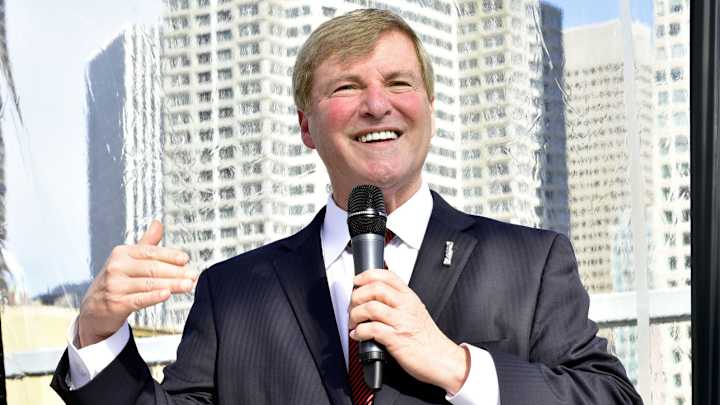
Saturday afternoon before the Super Bowl, at City View Metreon, a downtown San Francisco event venue, hundreds of guests mingled in the corporate-meets-politics-meets-charity-meets-football environment that is typical of Leigh Steinberg’s annual Super Bowl party. Midway through the event, the agent who inspired Jerry Maguire presented his 29th annual NFL Humanitarian Awards. For one of the recipients, newly hired Browns coach Hue Jackson, the presenter was none other than Paxton Lynch, the University of Memphis signal caller and Steinberg client who is vying to be the first quarterback taken in April’s draft. “I guess it’s not an accident he’s up here as well,” Steinberg’s partner quipped into the microphone.
There was a period when Steinberg wasn’t throwing his annual Super Bowl party, and when he didn’t have clients like Lynch. Once the most powerful agent in the NFL, Steinberg lost his business and declared bankruptcy after finally submitting to treatment for alcoholism in 2010. Steinberg has been public about his descent, including in his 2014 book, The Agent: My 40-Year Career Making Deals and Changing the Game. But now he’s back in the game. Heads turned when Steinberg signed Lynch on New Year’s Day, and next week he will be back at the NFL combine for the first time in 10 years. In a phone conversation this week with The MMQB, Steinberg talked about what’s changed since then—for him, and for the business he’s worked in for more than four decades.
VRENTAS: Let’s start with Paxton Lynch. How did you land him as a client?
STEINBERG: In October 2014, his father, David Lynch, called the office. Which, in an ideal scenario, is how it would happen, but it’s not how most of the business happens. He was just trying to gather information, but at that point Paxton was just entering what would be his sophomore year and really was not on the national or scouting screen really prominently. We just stayed in touch. And there is always a point at which a young quarterback elevates, because the position is so dependent on the amount of reps and seeing the field repetitively. There seems to be a point in their collegiate career when field command, reading defenses, comes together for a franchise-type quarterback. For him, there was an elevation during spring ball a year ago, and all of a sudden he began to read and throw dramatically better.
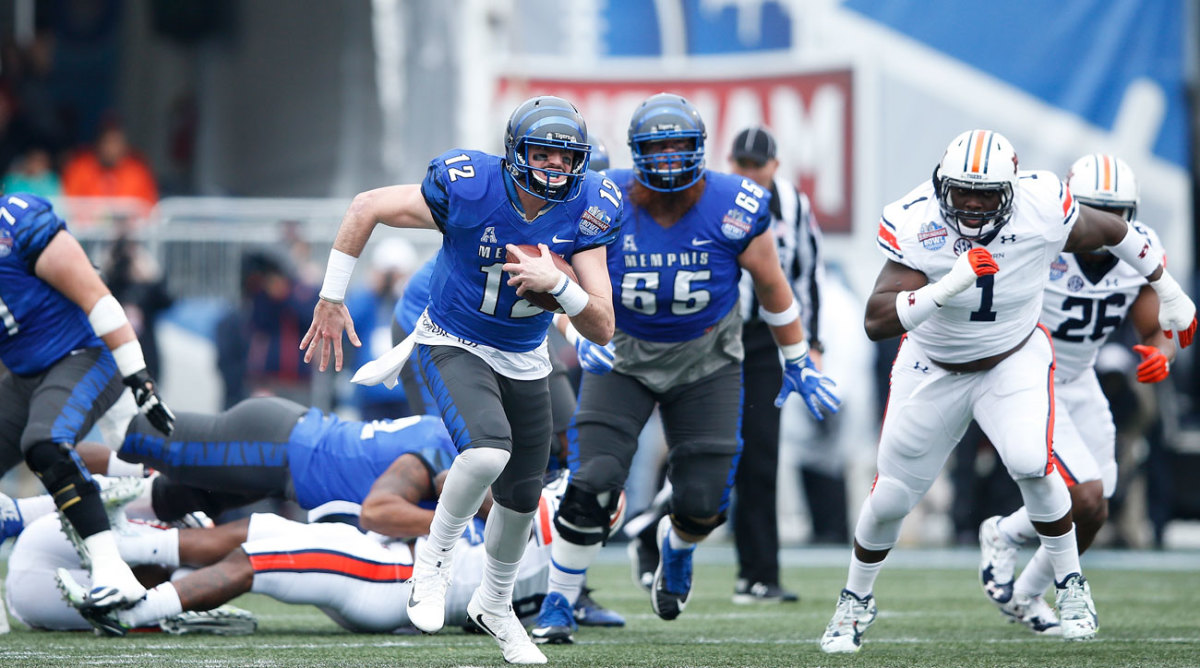
We stayed in touch with the family, and they are a faith-based family that is all about loyalty and making the son a good role model, so it matched with our concept of using that high athletic profile to make a difference in the world. And then for a franchise quarterback, in taking somebody at the top of the draft (not to be self-promoting) but I’ve had the first pick in the first round eight different years and 60 first-round picks. So when he would look into the future, he is also looking back all the way to [first Steinberg client] Steve Bartkowski, to Troy Aikman and Steve Young and Warren Moon, Ben Roethlisberger and Drew Bledsoe and Jake Plummer and Mark Brunell. Interestingly, [Paxton’s] father was a Steelers fan, and [Paxton] grew up idolizing Kordell Stewart, who is one of our clients.
I didn’t meet Paxton until very briefly during the summer, and then we had a longer meeting once the season was over. It was a match, and being able to take a young player through the scouting system and to maximize his ability to be perceived as a franchise quarterback, and having done it over and over and over again over 42 years. The next step is understanding that the engine that pulls the train is football. It is great to have a big endorsement profile, but there is so much pressure in that first year to produce, and the salary cap means that younger QBs have to start probably before they are really ready to read the field or be at the level of productivity they will ultimately reach. And so having a rookie player on every billboard as the center of an endorsement empire really doesn’t make much sense, because they have to prove it to the owner, GM, the coaches and the team that they are serious about football. The whole key is to mentor them through that. Just at my Super Bowl party, he was able to talk to Troy Aikman and Warren Moon and Kordell Stewart, and a whole series of people who could talk to him about how to conduct himself.
VRENTAS: What are you hoping Lynch can show teams at the combine next week?
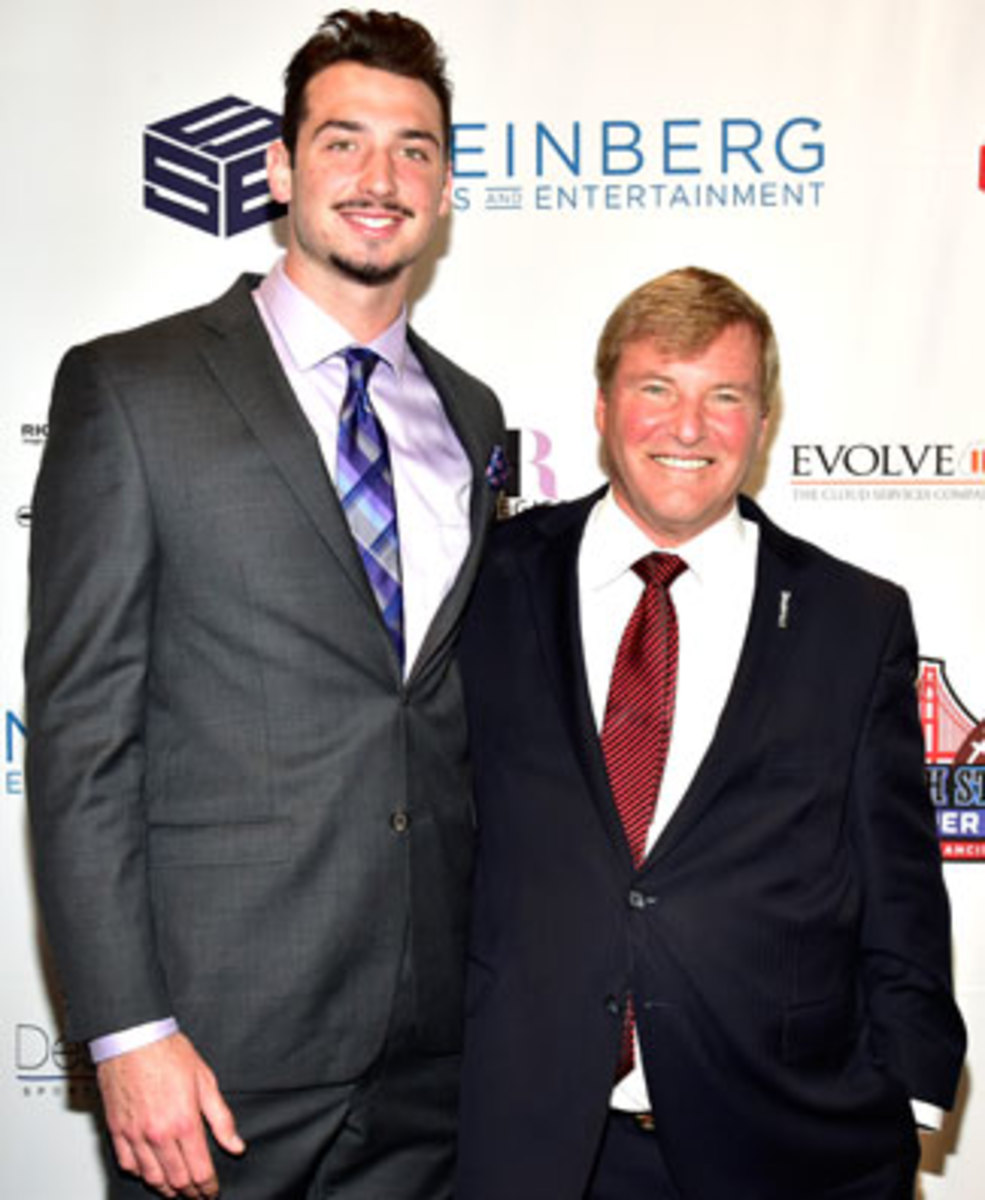
STEINBERG:
I think teams will like him one-on-one—he’s a natural leader, his teammates adored him, he’s very smart and picks up defenses quickly. So this is, in essence, his coming-out party. Because he didn’t play in an all-star game—he’s a junior—so this will really be the first chance the NFL has to take a look at him up close and personal.
VRENTAS: At your Super Bowl party, you had Lynch on stage, presenting one of your humanitarian awards to Hue Jackson. Coincidence, or an opportunity to make a good impression on the head coach of a QB-needy team?
STEINBERG: Well, the Super Bowl party is an opportunity for all of our draftees to meet owners, general managers, directors of player personnel, coaches out of uniform. So it is a good bonding experience. It’s a more casual setting, not a formal football setting. For players, especially juniors, who otherwise would not have interaction until the combine, it is a nice setting. So it’s one of 50 purposes of the party. He talked with Jack Del Rio, he talked with Hue Jackson, he talked with Kevin Demoff. Part of the reason we bring them out is that it will probably be the last time they see football from the outside. So I think it’s a good learning experience to see big business, politics, advertising, television, everything that surrounds pro football, and get an overview of the business they’re going into. When it comes times for them to graciously sign autographs, or do interviews with the press, some of the other obligations other than playing, they have a better sense of what is expected of them.
VRENTAS: You drew a lot of attention when you signed Lynch. Was nabbing one of the draft’s top QB prospects the moment when you could say, I’m back now?
STEINBERG: So, look, I would never try to compete with my younger self. That’s not the goal. I’m not sure that anybody will ever represent the first pick in the draft eight times again. I’m not sure anybody is going to do 60 first-round draft picks. We had our eighth player go into the Hall of Fame, Kevin Greene. So that’s not the goal; the goal is to find a much smaller number of quality athletes and try to make a difference in their life and help them fulfill their dreams. It was natural to pick a young, franchise-type quarterback because that’s the model I started with back in ’75, with Steve Bartkowski. I think that in my own mind, the “comeback” was being able to be six years sober, being a good father to my kids. The rest of this is just a blessing.
VRENTAS: How many clients do you have right now, compared to at your peak?
STEINBERG: We have eight. The five [draft prospects] this year, and then Garrett Gilbert, a QB on the Raiders; Khari Lee, a TE with Chicago; and Taylor Heinicke, the third QB with Minnesota. This was our first big year of recruiting. We are really just kicking off. We only got funded two years ago, and then the first year, I was mostly on book tour. But I’m sure it will grow from here. This is 42 years, but it feels fresh and exciting, and part of the fun of representing athletes is that you start each year with a new group that has fresh hopes and dreams. And it’s not just represent the athletes, it’s to work on issues like concussions; to use their high athletic profile to work on things like domestic violence and bullying; to put sports at the forefront in rolling back climate change; and also being involved with sports-themed motion pictures, like how I helped with Jerry Maguire and Any Given Sunday, and some TV projects.

In modern agentry, the representation component is one facet, but it is part of a larger facet. At our peak, which had to have been about 2000, 2001, we had 90 football players, and over 80 had been to the Pro Bowl. We had 60 baseball players. We had boxers like Lennox Lewis and Oscar De La Hoya, and about 15 basketball players, lottery picks. And then there were all the projects. Save the Giants in ’92 that kept the baseball team from moving from San Francisco to Tampa. Save the A’s in ’94 that kept that team in town. The less successful Save the Rams in ’94. So that was the size of the practice. Again, that’s not the goal this time. But what I have done since 1975 is to sit and carefully listen to the greatest hopes and aspirations and greatest anxieties and fears of young men, and try to do my best to help them fulfill them, and prepare them for a second career, and help them be role models, and then help prepare them to have the most dramatic success they can on the athletic field.
VRENTAS: With everything you have gone through before coming back, what was the low point?
STEINBERG: I think 2010, when I finally decided to break the denial about the fact that I was struggling with alcohol and made a decision to put aside my practice and go into sober living. At that point, I was in the grip of alcoholism, and when I emerged, there was a certain amount of wreckage in my life—emotional, financial, career wreckage. The thought of being where I am today was a dim and faint prospect. But it was a matter of proportionality. I was brought up with a dad who had two core values: one was to treasure relationships, especially family, and the second was to try to make a meaningful difference in a positive way in the world and help people who couldn’t help themselves. I was failing in both those categories. And I sat there and said, Hey, I am not a starving peasant in Darfur; I don’t have the last name Steinberg in Nazi Germany; I don’t have cancer; there is nothing wrong with my health, except alcohol. What excuse do I have?
Those core values never go out of style. There is a level of optimism and resilience that I have always had, which that period dimmed, but it was there. I had spent a good 30, 35 years trying to make a positive difference, both in the world and in this profession. While that seemed dim and abstract, I hadn’t committed gross crimes; I was self-destructive. And nobody gets back on their own. I went into a 12-step program with unique fellowship; I had the help of lots of different folks, my family and people like a Troy Aikman, who were always there and never gave up. At times it felt like Sisyphus, the Greek figure rolling the ball up the hill, but here you go, and now it is a very happy time and very exciting with a world of opportunity.
VRENTAS: What was the response from other agents when you returned? Did you hear a lot of negative recruiting against you?
STEINBERG: [laughs] I’ve always had the attitude that it’s a sad thing that agents are so hypercompetitive, because they really have a commonality of interest. And given the fact that there is a massive amount of players, and really enough for everyone to have clients, there should be collegiality in the profession. Especially with younger agents, I have always tried to mentor. We are throwing agent academies across the country; we did one in Newport Beach, Houston, Philadelphia, Chicago and San Francisco. I don’t see them as a competitors; I think the more ethical, principled, young agents we have out there that really view it as an opportunity to do good for athletes and the world, not just to make money. Among those people, hopefully I have been helpful.
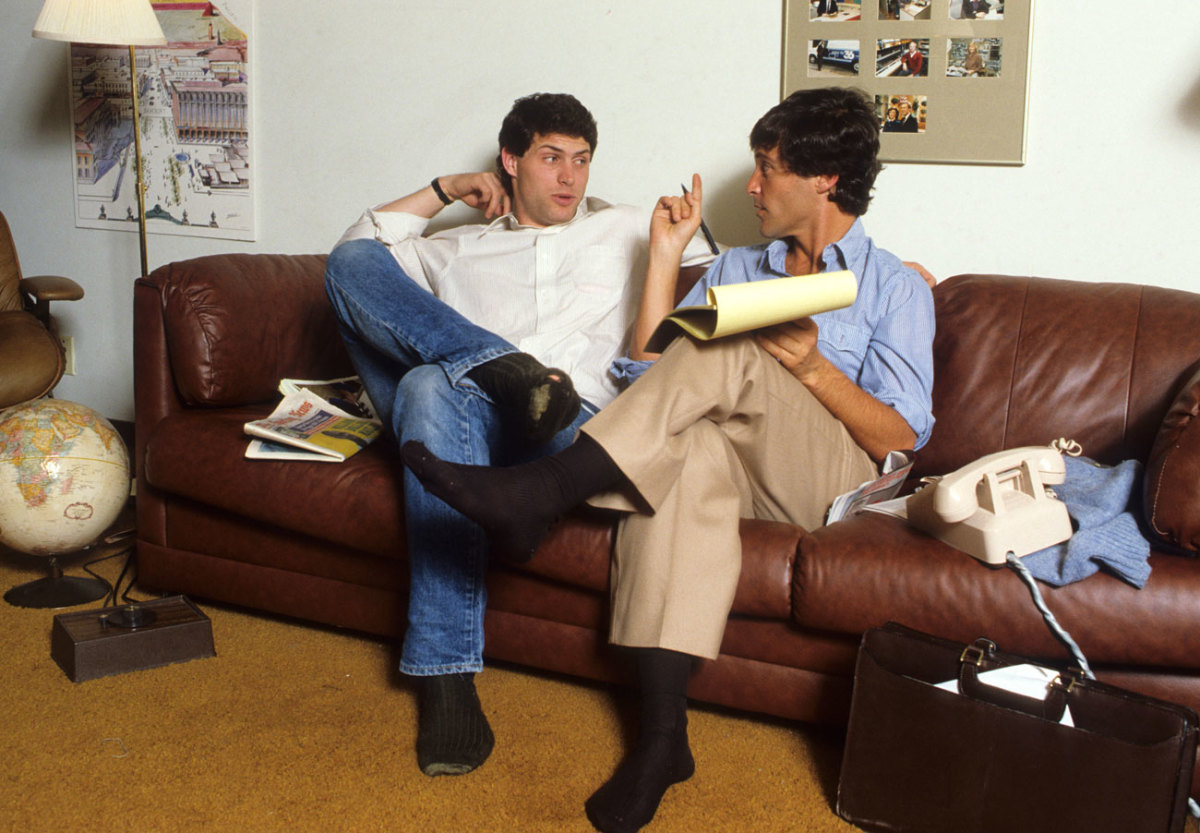
But it is a tough business in that I’m not sure under [anesthesia], you could get a top agent to say something nice about another one. It is sort of evocative of the Republican primary, where instead of pushing your own merits, people try to win by running down another person. We never presented that way. But it’s so inherent in it; it has always been part of it, and I was prepared for it. It really is sad because, for example, in this draft, people want to pair Jared Goff against Paxton Lynch. You know what? I went to Cal. Jared Goff is a great young QB. Who says there can’t be three or four young franchise QBs in the draft? It’s not necessary for me to be proud of Paxton Lynch to spend one second running down another quarterback. They’re all going to be good. That whole thing is ridiculous. Plus, what is going to happen in this draft is what always happens, which is certain teams will fall in love with certain players. You’ll have a coach, a QB coach, an executive, an owner, who will just like the style and think it fits with their team. Tampa loved Jameis Winston. Tennessee didn’t start out that way but came to love Marcus Mariota. And that’s how those picks went down. And the same thing will happen this year. We talked about Hue Jackson or the fact that the Browns owner was there at my Super Bowl party. You’re not going to lobby your way into having a team draft somebody. They’re going to come to their own conclusions.
VRENTAS: You’ve long been an advocate for concussion awareness and promoting the safety of the game. Where is the NFL now and what still needs to be done?
STEINBERG: Well, it’s not far enough along. When you see the statistics that there were 58 percent more concussions this year than last year—their statistic—that only accounts for diagnosed knockout hits, which is the tip of the iceberg. The reality is that every time an offensive lineman hits a defensive lineman, at the inception of every play, it produces a low-level subconcussive event. An offensive lineman can walk out of professional football with 10,000 subconcussive events, none of which have been diagnosed and none of which the athlete is aware of, but the aggregate of which almost certainly will lead to some form of diminished brain capacity. And if 50 percent of the mothers in the country know this, and tell their teenage sons, you can play any sport but not tackle football, it won’t kill NFL football, it will just change the socioeconomics of it. So that the same people who currently box or do UFC because they need to escape economic poverty will be the people who play. It becomes a gladiator sport.
We need to move urgently in protective helmetry; we need better diagnostic techniques on the sidelines. I think a serious look needs to be taken at how old kids should be when they start tackle football. We need nutraceuticals and pharmaceuticals to heal the brain. Remember what is different about this: Because of the breakdown of joints, we know an athlete with a long career in football may lean over to pick up their child at age 40 and have aches and pains. It’s another thing not to be able to recognize that child. We’re talking about the brain, the center of consciousness, memory, executive function and what it means to be a human being. And that’s why this injury is different. I don’t aspire to be the person who places the most dollars into the bankbooks of athletes who end up with dementia.
We can’t make this sport totally safe ever, but we can certainly make it a lot safer. What is happening here is there now is a profit incentive with these new technologies, so you’ve got sort of an Oklahoma land rush with people competing to see who can do the next big solution. Once you unleash the fields of engineering, technology, medicine on this, there are better solutions. It’s not going to make the game totally safe, but imagine me, back in 1994, with leading neurologists in the country and helmet manufacturers and all that, and we put out a white paper that we send to every football team and the league office suggesting we put neurologists on the sideline, a mandated regimen of concussion treatment, a whole series of suggestions. And we hear nothing back. Every focus on this takes us farther along, and so I applaud everyone in the field. I don’t have any dog in this hunt, but every single neurologist, every single new business, thank goodness for all of them. There is no upside in this issue. The players are in denial. If you step aside from the fact that you are supposed to have a fiduciary responsibility to your client, if you can ignore that, then let the games go on.
• YOUR 2016 OFFSEASON PRIMER: Emily Kaplan on the 10 storylines to watch over the next few months
VRENTAS: You’ve been open about your road back from alcoholism. What would you say to someone like Johnny Manziel, who attended rehab last spring and appears to still be struggling with many issues, among them possibly addiction?
STEINBERG: The reason I have been public about struggles that I had with alcohol is in the hope that it helps someone else. In the hope that someone who is out there struggling, confused, hopeless realizes help is available. The hardest thing to break in that whole disease syndrome is denial. That’s a disease that tells you, you don’t have a disease. They’ve never been open about what Manziel was in rehab for, so the last thing I want to do is diagnose him from a long way away. But if he has addiction issues, the real issue is saving his life. He has to put saving his life first in dealing with those issues. He’s still a young man, so if he could deal with whatever his addictive issues are, if he has them, first, he could still come back and have a long career. But he’s never going to have that if he doesn’t—anyone with that syndrome is going to continue to have incidents with public behavior, law enforcement, and the rest of it. It’s just part of it. Until you go to the root cause, the rest of it doesn’t make much difference. The talk about what team he fits with, or all the rest of it … I just saw Ryan Leaf on radio row, who is in some ways the biggest disappointment I had in my career. But Ryan is now working in a rehab facility helping other people. He looked healthy and good.
What a team is going to want to know from Johnny Manziel, is he behaviorally solid and stable, then after that, you get to the football issues. Because if he is behaviorally stable, someone will give him a second chance. We don’t throw young men on the trash heap of history because they made mistakes in their early 20s. We just don’t, in football. History is replete with people who struggled at a young age and came back and were very productive. It doesn’t seem like that now, but I’m just telling you. I don’t want to embarrass people, but we can go through the examples.
VRENTAS: We’ll end with this: How many times a day does someone still make a Jerry Maguire reference to you?
STEINBERG: What’s funny is that it’s now been 20 years, and there’s not a day that goes by when I’m out in public where someone doesn’t run up or walk up and say those four words [“Show me the money!”], as if it’s the first time I’ve ever heard that. Cameron Crowe spent about a year and a half following me, in the NFL draft in 1993, at Bill Parcells’ press conference, pro scouting day at SC, a number of games, the league meetings for a week, Super Bowl parties, and I told him stories, lots of stories. I took Cuba Gooding, Jr., with me down to the Super Bowl when it was in Phoenix and made him pretend he was a wide receiver; he had to hang out with Desmond Howard and Amani Toomer and pretend he was a client, to put him in role. I actually had to show the quarterback, Jerry O’Connell, how to throw a spiral, because he had gone to NYU and they didn’t have football there. It was an interesting experience.
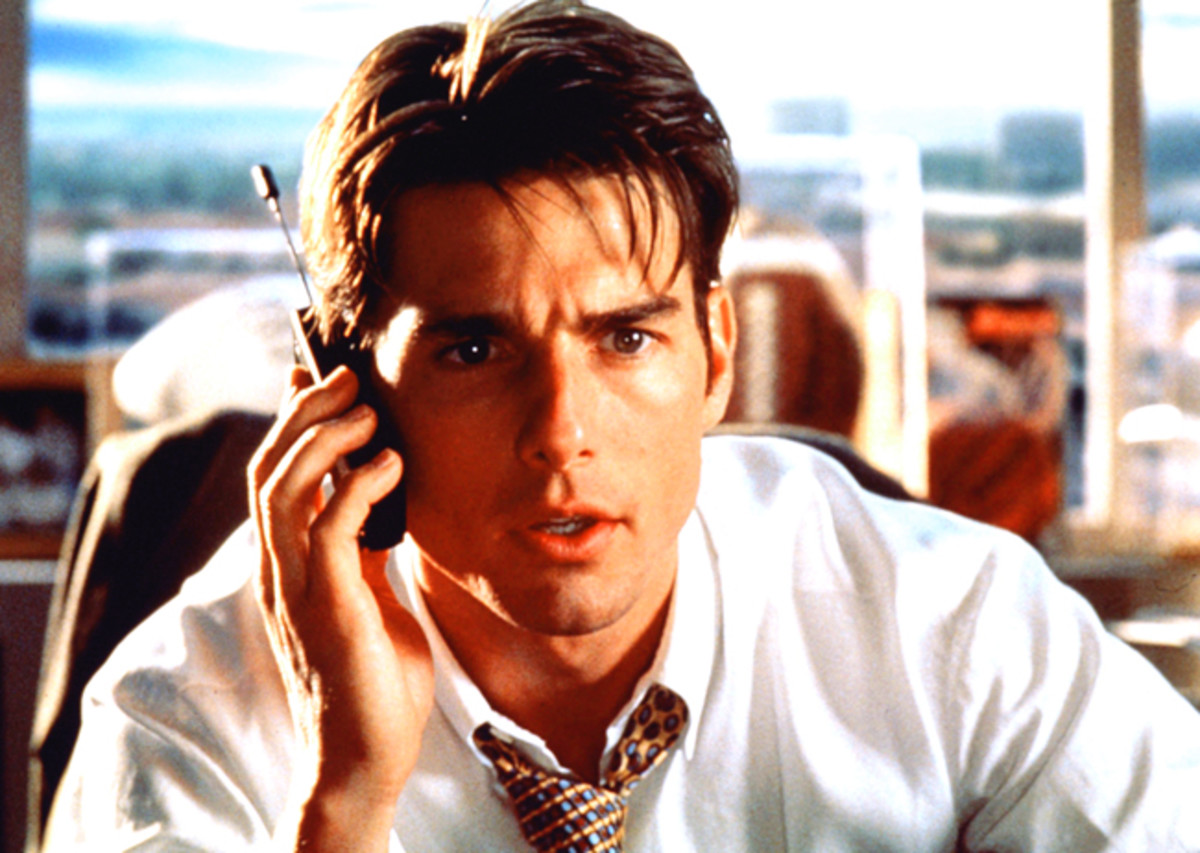
VRENTAS: Did you ever actually use the words, “Show me the money?”
STEINBERG: We were at the league meetings, and there were a couple players who were exempt from a franchise as free agents in 1993. One of them was Reggie White; the other one who was big was Tim McDonald. He was a strong safety for the Cardinals. So I was showing him off to different teams, trying to get interest in signing him. One night Cameron went up to Tim’s hotel room, and Lou Dobbs and Moneyline were on in the background. Cameron asked Tim, what is it that you are looking for in this experience? And so Tim gestured toward Moneyline. He said, I’m trying to get a team to show me some respect; I’m trying to get a team to show me a winning season; I’m trying to get a team to show me a place closer to California; and I’m trying to get a team to …’ and then Cameron wrote down, “show me the money.” Jerry Maguire is not my biography, it is Cameron Crowe’s character, but there are a whole lot of stories I told him that are in there. You wouldn’t think, with a movie that is 20 years old—and this generation is like, “who fought in the Civil War?”—but I have spoken on maybe 60 college campuses, and they have all seen it. The residual checks are nice, and they just keep coming. They just keep playing it on commercial TV somewhere, always. That’s one of the most popular films ever. It changed my life.
Question or comment? Email us at talkback@themmqb.com.
